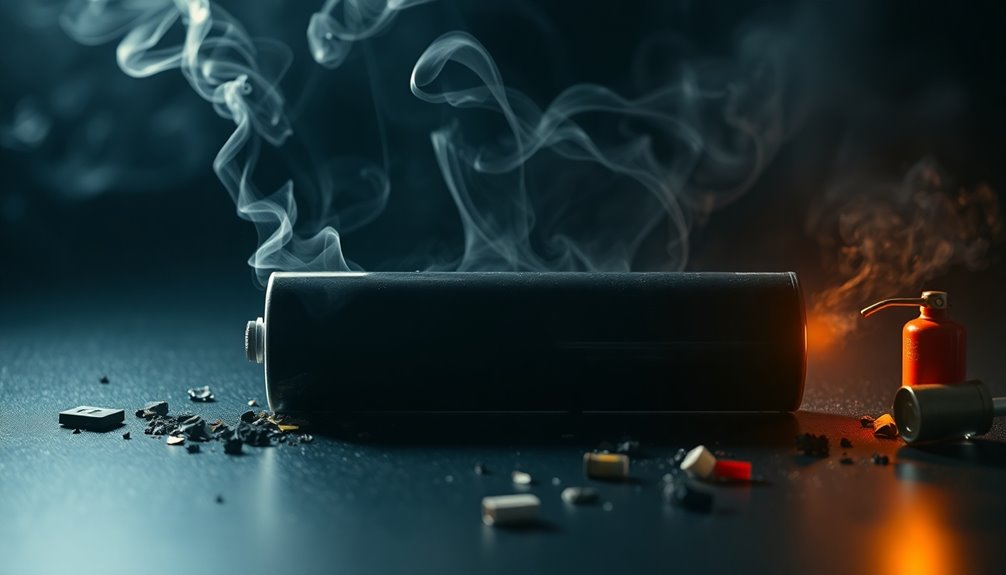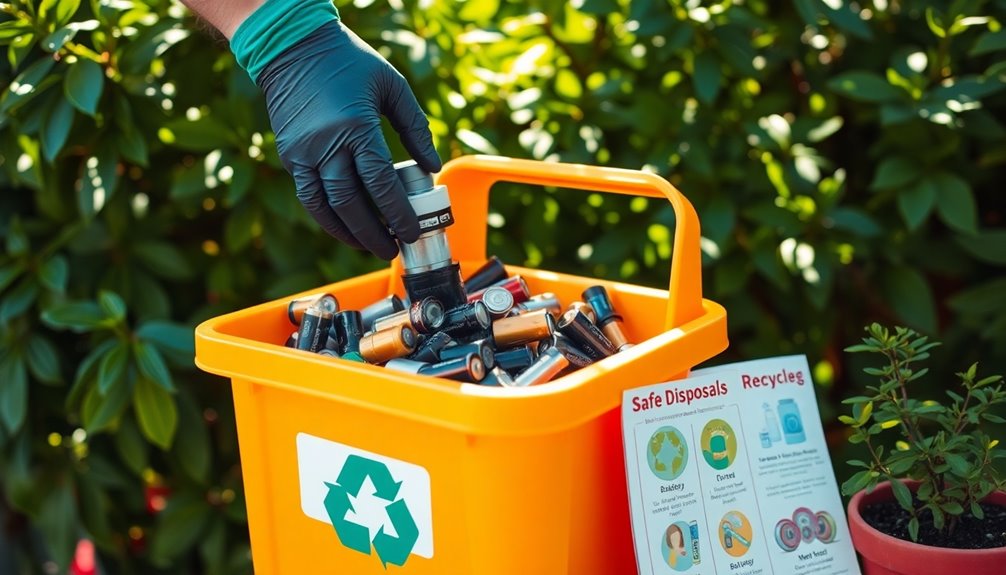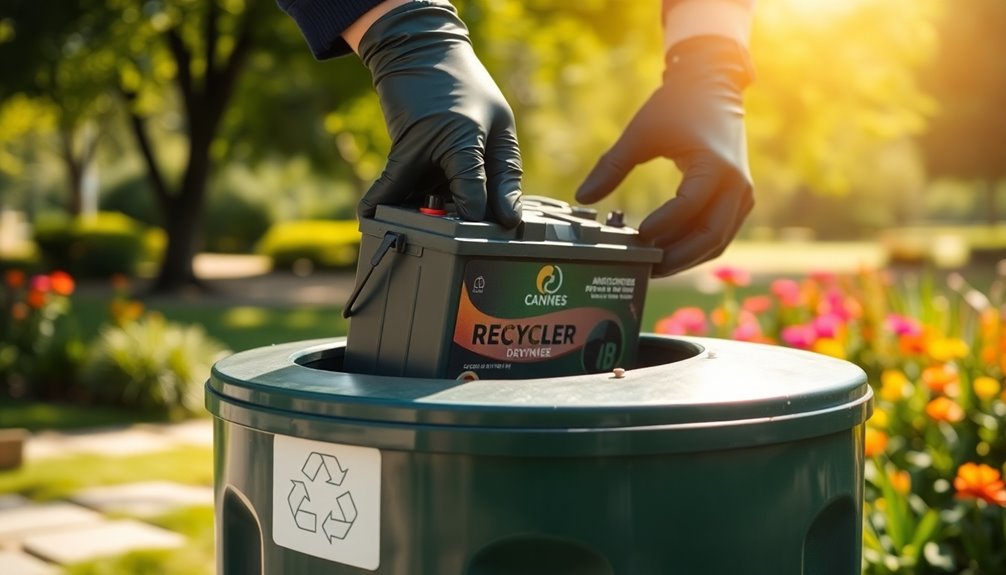Yes, lithium batteries can catch fire even when they're not in use. This can happen due to residual power causing thermal runaway or internal short circuits. Storing them improperly, like near heat sources or flammable materials, increases this risk. Damaged batteries are particularly hazardous, showing signs like swelling or leaking fluids. To stay safe, store batteries in cool, dry places and use fireproof containers. Furthermore, regularly inspect your batteries for any signs of wear. If you're curious about more ways to guarantee battery safety, there's plenty more to uncover.
Key Takeaways
- Yes, lithium batteries can catch fire even when not in use due to internal short circuits or residual power leading to thermal runaway.
- Overheating, especially near heat sources or in direct sunlight, can trigger decomposition of electrolytes, resulting in flammable gas emissions.
- Signs of battery damage include swelling, leaking fluids, and unusual odors which can increase fire risk and necessitate immediate removal.
- Proper storage in cool, dry places and using fireproof containers can significantly reduce the risk of ignition for inactive batteries.
- Regular inspections and staff training on battery management are crucial for preventing fires related to inactive lithium batteries.
Overview of Lithium Battery Safety
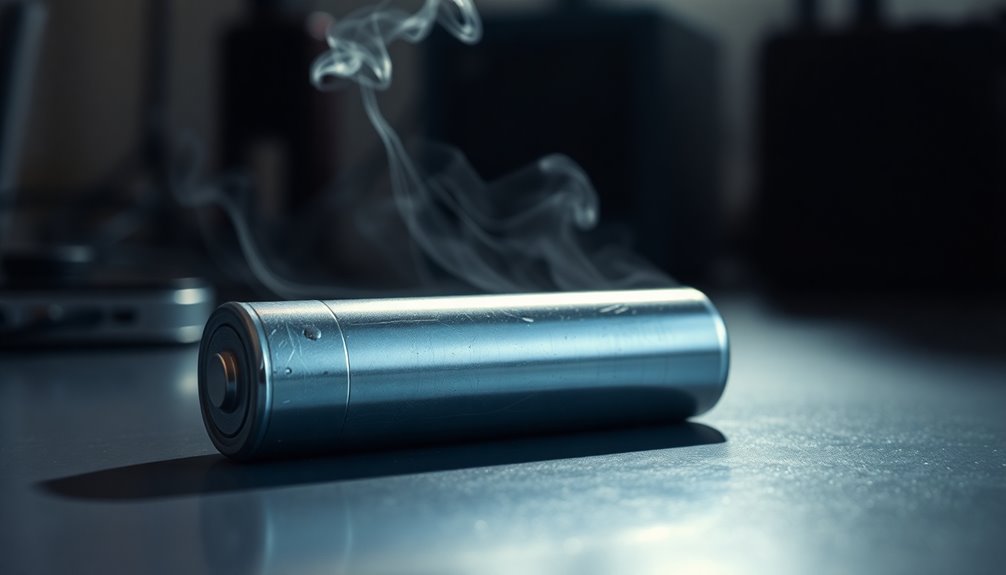
When it comes to lithium battery safety, understanding the risks is essential, especially since these batteries can catch fire even when they're not in use.
Lithium-ion batteries pose a considerable fire hazard due to residual power that can lead to thermal runaway if damaged or improperly stored. To mitigate this risk, you should implement effective safety measures.
Store batteries away from heat sources and direct sunlight, as electrolytes can decompose at temperatures around 130°C. Regularly inspect your batteries for signs of wear and keep them in fireproof containers away from flammable materials.
Causes of Lithium Battery Fires
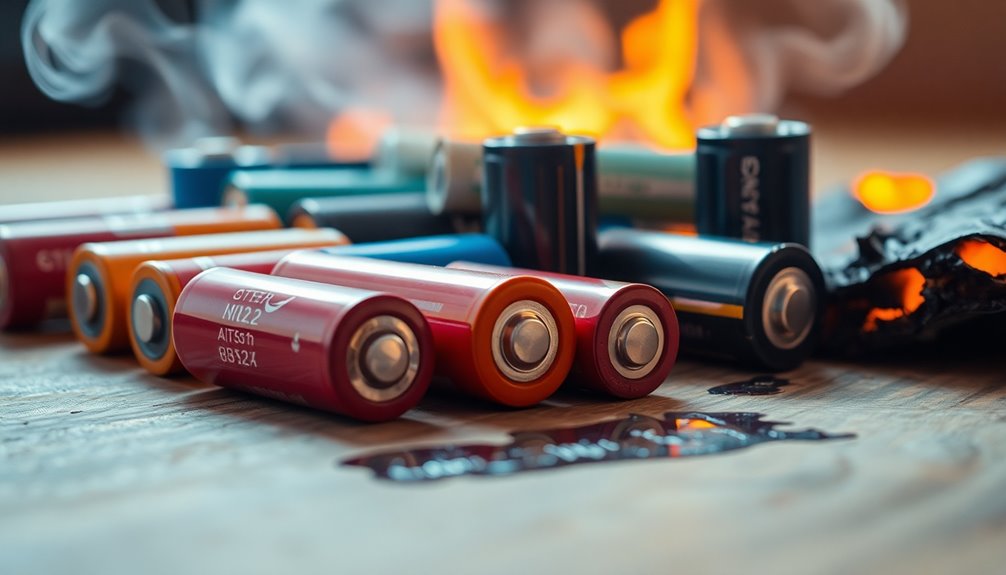
Lithium battery fires can occur for several reasons, often stemming from internal defects or external factors. Internal short circuits account for about 25% of these incidents, which can happen even when the battery isn't in use.
If you expose your battery to high temperatures, like leaving it in direct sunlight, you risk triggering thermal runaway, leading to fires during storage. Once the battery's electrolyte breaks down around 130°C, it releases flammable gases that can ignite under pressure or heat.
Additionally, improper storage near flammable materials increases the chance of spontaneous ignition. Regularly checking your batteries for damage or swelling is essential, as these conditions can release toxic gases and pose serious fire hazards, even when they're not actively used.
Thermal Runaway Explained

When lithium-ion batteries overheat, they can enter a dangerous state known as thermal runaway.
This process starts with internal short circuits or excessive heat, leading to rapid and uncontrollable reactions.
Understanding the causes and consequences of overheating is essential for keeping these powerful energy sources safe.
Causes of Thermal Runaway
Although various factors can contribute to thermal runaway in lithium-ion batteries, it typically starts with overheating or internal short circuits.
Here are some key causes to watch for:
- Overheating: Battery temperatures can soar due to external heat sources.
- Internal short circuits: These account for about 25% of battery fires, often arising from manufacturing defects or extended usage.
- Physical damage: Any deterioration in the battery's structure can lead to dangerous conditions.
When temperatures exceed 150°C, the electrolyte breaks down, releasing flammable gases and accelerating reactions.
This chain reaction can escalate rapidly, posing severe fire risks. Understanding these causes is essential for preventing hazardous situations and ensuring safe battery use.
Consequences of Overheating
Overheating can lead to severe consequences, especially in lithium-ion batteries, where thermal runaway poses significant risks.
When temperatures exceed 150°C, uncontrollable reactions can trigger fires or explosions. Internal short circuits, often due to a manufacturing defect, account for about 25% of battery fires. These short circuits can initiate thermal runaway, causing rapid chain reactions that escalate within seconds.
Additionally, the breakdown of the electrolyte at around 130°C releases flammable gases like oxygen and carbon dioxide, increasing the fire risk. Improper charging practices and external heat exposure can further exacerbate overheating, leading to dangerous situations.
It's vital to monitor battery conditions to prevent these severe consequences and guarantee safety.
Risks of Damaged Batteries
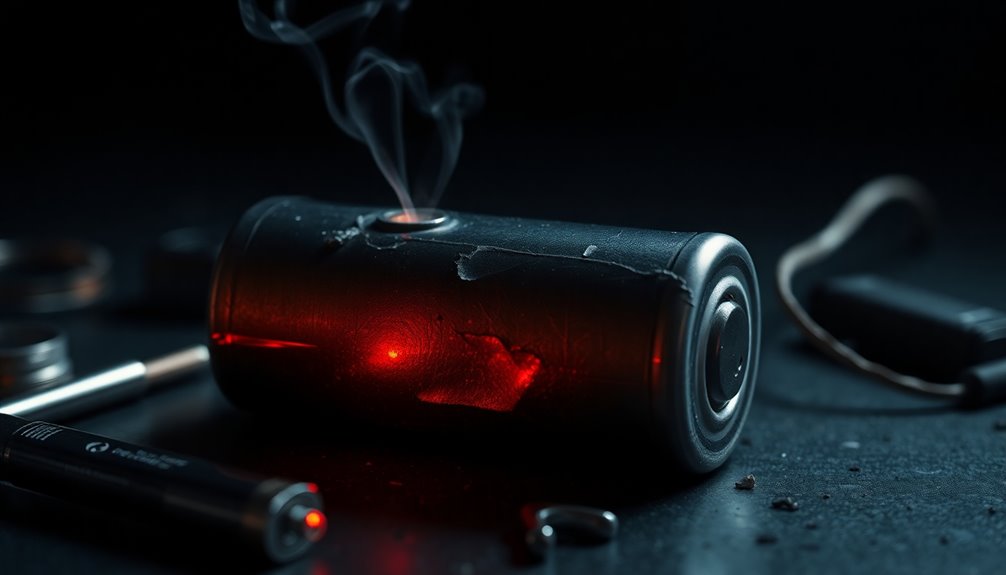
Damaged lithium-ion batteries pose significant fire risks, as they can release flammable vapors even when they're not in use.
You need to be vigilant about the signs of damage, which may include:
- Swelling or bulging
- Leaking fluids
- Unusual odors
Ignoring these signs could lead to a serious fire hazard. A damaged battery can easily enter thermal runaway, a condition where it overheats uncontrollably, potentially igniting or exploding.
It's essential to remove compromised batteries immediately from facilities to mitigate these risks. Regular inspections help guarantee battery integrity, while training staff to recognize and manage damaged lithium-ion batteries is critical for safety.
Don't underestimate the importance of being proactive with battery maintenance and management to prevent dangerous situations.
Safe Storage Practices
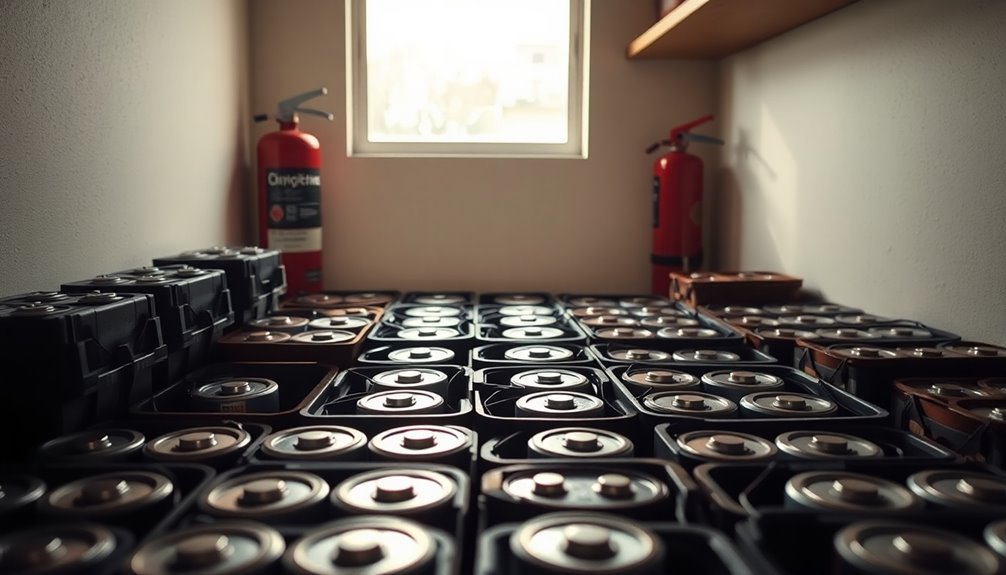
When storing lithium batteries, keep them in a cool, dry place away from heat and sunlight to prevent risks.
Using fireproof storage solutions adds extra safety against potential hazards.
Regularly check the conditions to guarantee they're stable and secure.
Ideal Temperature Conditions
To keep your lithium batteries safe and functioning at their best, it's crucial to store them within the ideal temperature range of 50°F to 85°F.
Exceeding these limits can lead to severe risks, including battery rupture or thermal runaway.
Consider these tips for safe storage:
- Avoid direct sunlight and heat sources.
- Maintain a cool, dry environment, ideally room temperature.
- Regularly check storage conditions for cleanliness and organization.
Fireproof Storage Solutions
Storing lithium batteries safely is essential, especially as you manage the risks associated with potential fire hazards.
Using fireproof storage solutions minimizes the chance of fire, particularly in areas near heat sources. Keep your batteries in a cool, dry space away from flammable materials and direct sunlight to prevent overheating and reduce the risk of thermal runaway.
Regularly check the storage conditions to guarantee temperatures stay between 50°F to 85°F.
Implement safe storage practices by isolating damaged batteries from intact ones, as compromised cells can emit flammable vapors.
You should also utilize diagnostic tools or mobile apps to monitor battery health, guaranteeing you only store batteries in good condition, thereby enhancing your safety features against fire risks. Additionally, it's important to recognize that energy-efficient technology can reduce overall fire hazards by optimizing power usage and minimizing excess heat generation.
Preventative Measures for Users

While it's easy to overlook battery safety, taking a few simple precautions can markedly reduce the fire risks associated with lithium batteries.
Implementing these preventative measures is essential:
- Regularly monitor battery health with diagnostic tools or mobile apps.
- Purchase batteries from reputable manufacturers to minimize defects and fire hazards.
- Store batteries in a cool, dry place, away from heat sources.
Emergency Response Techniques

When facing a lithium battery fire, your first priority should always be personal safety.
If the situation escalates, isolate the fire by moving the battery away from flammable materials and consider using fireproof containers or sand.
Make sure you have the right extinguishing agents on hand, like Class D or CO2 extinguishers, to effectively tackle the flames.
Personal Safety First
In the event of a lithium battery fire, your personal safety should always be the top priority.
If you encounter such a situation, remember to:
- Evacuate the area immediately.
- Wear protective gear to shield yourself from potential hazards.
- Have suitable fire suppression tools ready.
Act swiftly to guarantee your safety and that of others.
Fires caused by lithium batteries can escalate quickly, so don't hesitate to leave the premises.
Avoid trying to extinguish the flames without proper equipment, like Class D or CO2 extinguishers, as these are essential for effectively managing lithium battery fires.
Always prioritize personal safety and prevent further risks by moving away from the affected area until help arrives.
Your well-being is paramount in emergencies.
Isolate the Fire
To effectively manage a lithium battery fire, it is crucial to isolate the fire as quickly as possible. Move the battery away from flammable materials to prevent further ignition. Use fireproof containers or sand to cut off the oxygen supply, aiding in extinguishing the flames. Always prioritize personal safety by wearing protective gear and evacuating if necessary.
| Action | Purpose |
|---|---|
| Move battery away | Prevents further ignition |
| Use fireproof containers | Cuts off oxygen supply |
| Monitor after extinguishing | Prevents risk of reignition |
| Wear protective gear | Guarantees personal safety |
Suitable Extinguishing Agents
Understanding which extinguishing agents are suitable for lithium battery fires is essential for effective emergency response.
Here are some key options:
- Class D extinguishers: Specifically designed for metal fires, they're ideal for lithium-ion battery fires.
- CO2 extinguishers: Help cut off the oxygen supply, suffocating the fire.
- Fireproof containers or sand: Isolate and smother the flames effectively.
Myths About Battery Fires
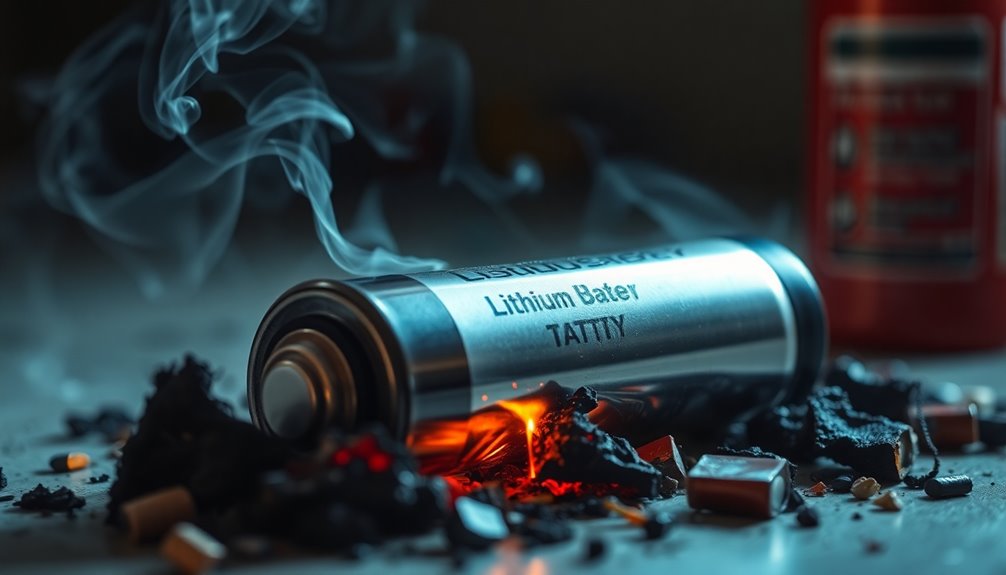
While many people believe lithium-ion batteries are safe when not in use, this misconception can lead to serious fire risks. Batteries can still pose hazards due to residual power and potential internal damage, which may cause thermal runaway.
You might think it's fine to store batteries anywhere, but they should be kept away from heat sources and direct sunlight to prevent overheating. Damaged batteries aren't harmless either; compromised cells can release flammable vapors, creating fire risks even when idle.
Furthermore, disposing of lithium batteries with regular waste is dangerous; they need proper recycling to avoid potential fires during processing.
Finally, always use the correct charger, as the wrong one can lead to overcharging and increase fire risks, even when the battery's not in use.
Innovations in Battery Technology
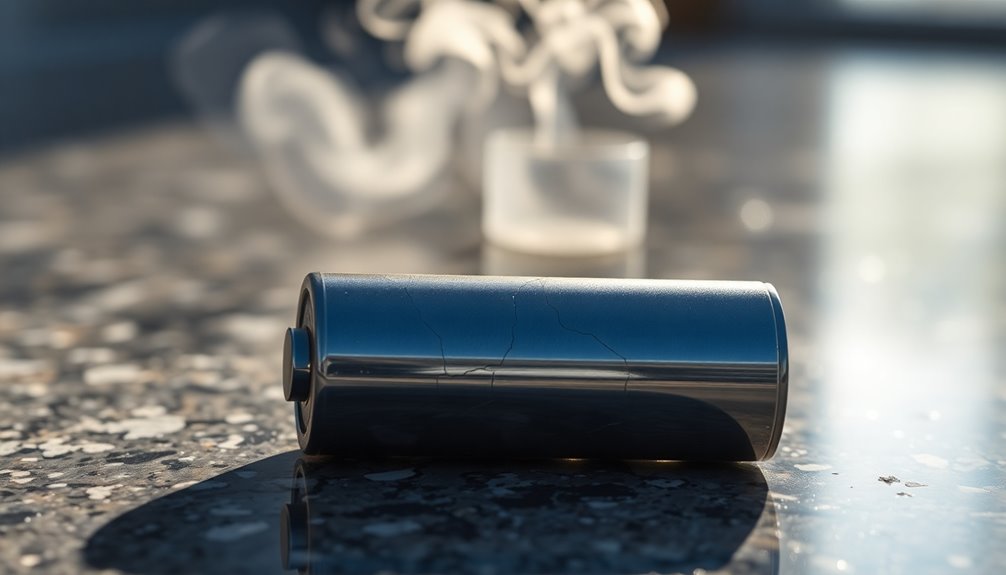
Misconceptions about lithium batteries often overlook the advancements in technology aimed at improving safety and performance.
Here are some key innovations making a difference:
- Solid-state batteries, reducing the risk of thermal runaway.
- Self-healing separators to prevent short circuits and enhance battery longevity.
- Advanced battery management systems that optimize charging and discharging.
These innovations not only boost energy density but also incorporate essential safety measures.
For example, integrating thermal monitoring sensors can lower fire risks by up to 40%.
As these technologies evolve, they greatly diminish the chances of overheating and related hazards.
Importance of Proper Disposal
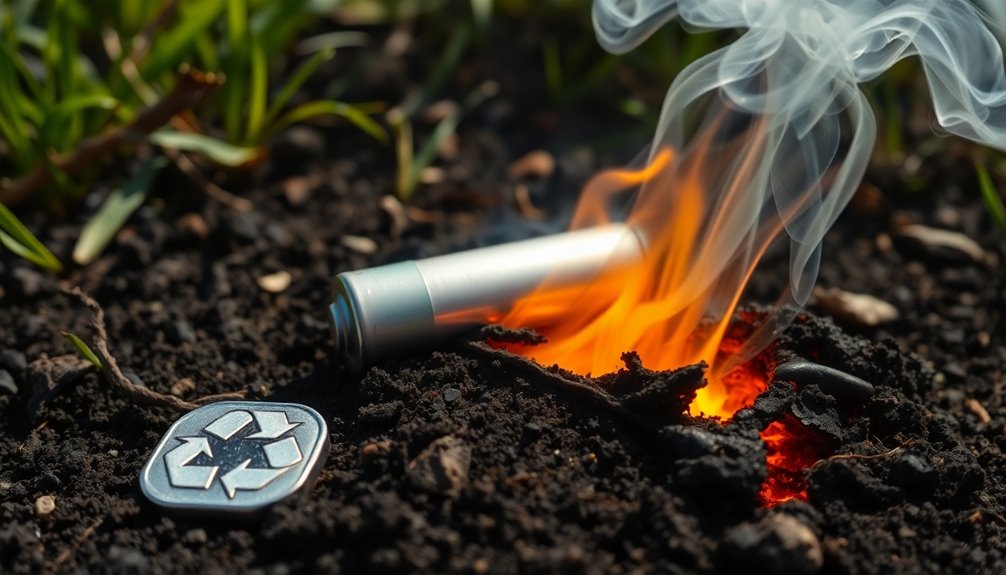
Proper disposal of lithium batteries is essential to preventing fire hazards and environmental damage. Improper disposal can cause a fire due to punctures or exposure, as even non-functional batteries still hold residual power.
To mitigate the risk of lithium-ion battery incidents, always take batteries to designated recycling centers or retailer drop-off locations. Before disposal, use non-conductive tape to cover the terminals, reducing the chance of accidental contact during waste processing.
Store discarded batteries outdoors or near exits, ensuring they're separated by at least 10 feet to minimize risks. Educating yourself and others on these best practices and developing clear disposal protocols is crucial to keeping everyone safe from potential dangers associated with lithium battery disposal.
Frequently Asked Questions
Can Lithium Batteries Ignite When Not in Use?
Yes, lithium batteries can ignite even when they're not in use.
If they're damaged or have manufacturing defects, they can release flammable vapors, posing a fire risk. Exposure to high temperatures, like direct sunlight, can also lead to dangerous conditions.
Improper storage near heat sources or flammable materials increases this risk.
Regularly check your batteries for signs of swelling, leakage, or odd odors to help prevent potential fires.
Stay safe!
How Likely Are Lithium Batteries to Catch Fire?
When it comes to lithium batteries catching fire, you should be aware that the risk is real.
While they're generally safe, factors like damage, manufacturing defects, and exposure to high temperatures can increase the likelihood of a fire.
It's essential to monitor their health regularly and store them properly to prevent potential issues.
Keeping batteries away from heat sources and using fireproof storage can help minimize this risk considerably.
What Is the Biggest Cause of Lithium-Ion Batteries Exploding?
What makes lithium-ion batteries so dangerous? The biggest cause of explosions is thermal runaway, which happens when temperatures soar past 150°C.
This can be triggered by internal short circuits, manufacturing defects, or even physical damage. Overcharging and using incompatible chargers also increase the risk of overheating.
Plus, exposing the batteries to high temperatures or direct sunlight can further compromise their safety. Staying aware of these factors helps you prevent potential hazards.
Can Lipo Batteries Catch Fire When Not in Use?
Yes, LiPo batteries can catch fire when not in use.
If you store them improperly, like in high temperatures or direct sunlight, there's a risk of overheating.
Even discharged batteries can pose hazards since they might still have residual energy.
It's vital to inspect them regularly and use fireproof storage cases.
Keeping them away from heat sources will help minimize any potential risks and guarantee your safety when they're not actively being used.
Conclusion
In summary, lithium batteries can be as unpredictable as a ticking time bomb if not handled properly. By understanding the risks and adhering to safe storage practices, you can greatly reduce the chances of fire. Remember, treating your batteries with care is essential for your safety. As technology evolves, staying informed about innovations and proper disposal methods will keep you one step ahead in preventing potential hazards. Don't let negligence spark a disaster!

